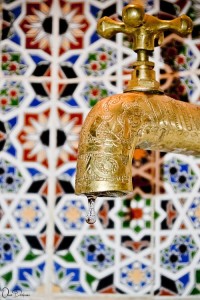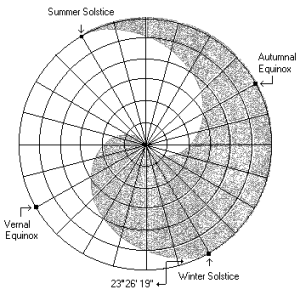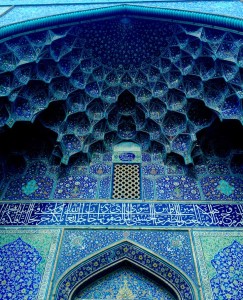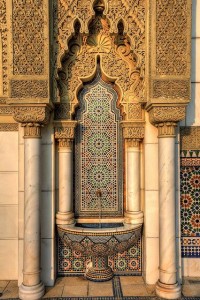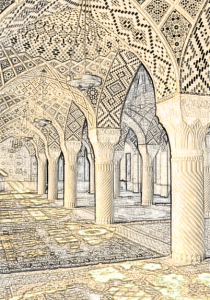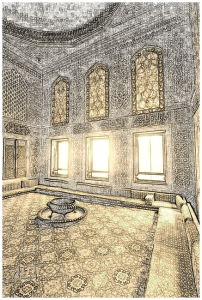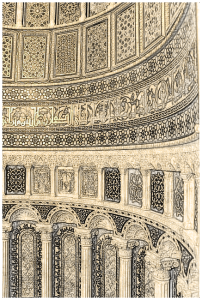1001 Years Of Missing Islamic Martial Arts
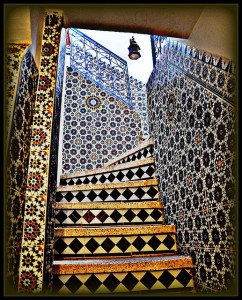 Adapted From: 1001 YEARS OF MISSING MARTIAL ARTS by Master Mohammed Khamouch
Adapted From: 1001 YEARS OF MISSING MARTIAL ARTS by Master Mohammed Khamouch
Early Muslim merchants and travelers of Arab and Persian origin, voyaged to China in their quest for the silk trade, enduring perilous journeys to establish strong trade relations that endured for centuries. This produced a dramatic increase in economic growth within Muslim mercantile communities, especially in the ancient imperial city of Chang’an (present day Xian) in Shaanxi Province, the eastern terminus of the Silk Roads and the Maritime (Silk Route) port cities of al-Zaytun (Quanzhou) and Guangzhou (Canton).
As Muslims settled and widely dispersed throughout the country, rapid progress was achieved in allowing Muslims to govern their own internal affairs, build Mosques and appoint a Qadi (Muslim judge) who adjudicated according to Islamic (Sharia) law. When a military commander An Lu-Shan revolted against Emperor Su T’sung in 755 CE, an urgent plea was made to the Abbasid Caliph Abu Jafar al-Mansur who immediately sent a contingent of 4000 soldiers who eventually quelled the unrest and recaptured the city.
Chang’an, retained its normality once more and continued in its splendour under the Tang Dynasty (618-907 CE), as the world’s most thriving metropolis. During the Tang period a variety of different cultures, knowledge and spiritual beliefs, all interacted with each other; thus attracting many keen Japanese and Korean scholars who wished to learn and observe Chinese arts.
Many Abbasid warriors who helped the Emperor accepted the invitation to stay and settled in China, marrying Chinese wives thus beginning a natural process of integration into Chinese society while maintaining Islamic identity and stressing a common lineage and descent from venerated Muslim ancestors. These ancestors were colloquially known as “Hui Hui” down the centuries, and founded one of the longest lived and rarest of all Muslim minorities in the world. This colorful pattern is implicitly mentioned in the following Quranic verse:”O mankind! We created you from a single (pair) of male and female, and made you into Nations and tribes, that ye may know each other” (Qur’an 49:13).
[Islamic martial arts developed by muslims living in China existed from very early days of Chinese marital arts. By comparison to the Shaolin fighting system, the oldest evidence of Shaolin participation in combat is a stele from 728 AD that attests to two occasions: a defense of the Shaolin Monastery from bandits around 610 AD, and their subsequent role in the defeat of Wang Shichong at the Battle of Hulao in 621 AD.]
During the Mongol Yuan Dynasty (1279-1368 CE), founded by Kublai Khan, Muslims were granted special status and were known as “Da’shma” or “Da’shman” (meaning the learned one), because of their outstanding ability and contribution as statesmen, astronomers, astrologers, doctors, pharmacist, architects, businessmen, philosophers and authors. P’u Sung Ling, popularly known as one of China’s few great novelists, wrote stories considered as the Chinese equivalent of the Arabian “1001 Nights”, obtainable in many languages.
The efficient management of Kublai Khan’s royal court and palaces, which included over thirty high Muslim officials, was noticed by Marco Polo (1254-1324 CE), who was awe-struck by the mighty ruler. Out of twelve administrative districts, eight had Muslim governors and Muslims occupied numerous other senior positions in civil power. They were also military advisors, as well as martial arts experts and bodyguards who escorted caravans on long perilous journeys. Muslim scientists were invited to participate in various projects including the construction and running of the famous observatory in Shensi (Shaanxi).
Many distinguished Muslims responded to the Chinese need to fill strategically important gaps and excelled in all fields. Two expert technicians, who made “Hui Hui” (Muslim) cannon, were Allah-uddin of Mufari, who was later promoted to Deputy Wan Hu (the promotion waranting the change in name), the second in command of an army of 3,000 – 7,000 men, and Ismail of Syria, who became the chief superintendent in the manufacture of “Hui Hui” (muslim) cannons. Cannons made by these Muslim technicians was deployed during the Yuan Dynasty to shell the Hsiang Yang Fort in Hubei Province. The two technicians were possibly some of the earliest to use gunpowder.[1]
Syed ‘Umar Shams-uddin (known as Sayyid al-Ajall), a noble figure and descendant of the Prophet, contributed a great deal to the achievements of the Yuan Dynasty, and with his son Nasir al-Din actively proselytized (made dawa) and converted thousands of people to Islam. As a young boy, he was surrendered by his father (king of Bukhara) as a hostage to Ghengis Khan, who took him to Peking, where he was educated in both Chinese and Arabic. Being very intelligent, he was able to assimilate both Mongolian and Chinese cultures. In 1271 CE he was appointed by Kublai Khan as Governor of Yunnan and posthumously awarded with title of “Prince Hsien Yang”. He shed new light on education, Chinese law, improved agriculture and was the first to establish the Confucian temples in Yunnan, despite being a devout Muslim.
Shams-uddin studied three types of ancient Chinese books, called the “Books of Changes” dating back to 909 BCE, which are understood by only a few scholars today. Shams-uddin was responsible for the origin of the “Tai T’si”, or Yin and Yang symbol, an ancient concept centered on the Daoist philosophy and principle of unity of the two cosmic forces.[2] When he died in 1279 CE, aged 67, many attended his funeral, and the non-Muslim Chinese people built a shrine in his honour, and a cenotaph in Guangzhou.
The opposing forces of Yin and Yang flow into one another and neither the positive or the negative aspect of the universe can exist without the other. In the West, the term martial arts denotes the art of war, derived from the name of Mars, the Roman god of war.[3] However the philosophical background to Chinese martial arts is contained in the common idiom of “Go-Ju”, “Go” meaning “hard” and “Ju” means “soft”. The negative (Yin) element is the hard Kung fu, and the positive (Yang) element is the soft Kung fu (Yin and Yang relate to the flow of energy in the body which martial arts sought to use in combat through different techniques that had different results).
There are literally several hundreds of different types of martial arts in China, all stemming from just a few distinct branches. These consist of mainly the external (hard) Kung fu, and there are much fewer internal (soft) Kung fu styles. Muslim Kung fu, however, ranks amongst the best of both, the internal and the external popular styles of China.
In China however, elements of the Chinese martial art, known in the Western world by the popular name of “Kung Fu”, can be traced back to circa 2700 BCE during the rule of legendary Yellow Emperor Huang Ti, who fought and defeated his opponent Chi Yuo, using traditional Chinese wrestling methods.[6] Such a wrestling style is different to that of western wrestling or judo, and was known as Shuai Chiao, or Shuai Jiao. It comprised hand and low leg tangling and kicking and evolved around 700 BCE as one of the earliest forms of organized fighting systems, sharing strikingly similar techniques to those of Kung fu.[7]
The late Grandmaster Ch’ang Tung Sheng (1905-1986), a Hui Muslim from Hubei Province, was one of China’s most prominent exponents of the ancient art of Shuai Chiao. According to Matt Mollica (5th Teng), a senior student of Grandmaster Ch’ang, “attacking Ch’ang Tung Sheng was like sticking your hand in a blender”. The latter accepted all challenges from many different styles and was undefeated for over half a century.
Martial arts, emanating from the Far East, have deep mystical and spiritual foundations, and are entwined with the doctrines and philosophical beliefs of Confucianism, Buddhism, Taoism and finally Islam. Islam aroused the appetite of its followers to practice and excel in Wu Shu (the name for military arts in Chinese), as a sacred practice. This is reflected in a famous Islamic proverb, a saying of the Prophet Muhammed, inspiring Muslims to “seek knowledge, even unto China”.
Spiritual belief played an influential role in the development of the Far Eastern fighting skills that we know today. Although the origins of Chinese martial arts go back to well over 5000 years, a major celebration took place a decade ago to mark the 1500th anniversary of Shaolin Monastery, where centuries of careful study of various animals and their fighting techniques have been incorporated to produce uniquely skillful fighting techniques. Some of these are physically imprinted on the interior and exterior of the Shaolin temple complex; such as the “Thousand Buddha’s Hall” where years of treading and stamping by monks during training has worn depressions on the surface of the brick floor.[9]
Various patterns of fighting skills gradually evolved into effective human forms of combat. The ferocious Kung fu style popularly known in China as “Tong Lun” originated nearly four hundred years ago towards the end of the Ming Dynasty, when Master Wang Lang of East Shan-Tung Province of China observed a fight between a praying mantis and a grasshopper.
Shaolin Temple, Si Lum in Chinese, one of the most famous religious establishments in all China, is situated near Mt. Songshan, 15 kilometers northwest of Dengfeng County town in Henan Province. It was built in 495 CE, on the orders of Emperor Hsiao Wen of the Northern Dynasty (386-534 CE) in honour of a visiting monk, Batuo (Fu Tuo in Chinese) from India.[10]
An enigmatic legendary figure Bodhidharma (P’u-t’i-ta-mo in Chinese or Daruma Daishi in Japanese), third son of the Brahman king and twenty-eighth patriarch, left Southern India and voyaged to Guangzhou, where he was granted audience by Emperor Wu Ti of the Liang Dynasty (502-577 CE). When Bodhidharma finally arrived at the Shaolin temple, in his search for spiritual enlightenment, he began to preach Ch’an Buddhism to his disciples, along with various breathing techniques and exercises to improve their ability to withstand long periods of static meditation. Such training exercises are believed to have been the foundation of modern martial arts, and his Buddhist teachings formed the basis of a new school of Buddhist philosophy recognized as “Ch’an” in China and “Zen” in Japan.[11]
Over a century later, in 651 CE, during the Tang Dynasty, a delegation was sent to China by Caliph Uthman Ibn Affan (r. 644-656 CE) from Madina, led by S’ad Ibn Abi Waqqas (d. 674 CE), from Bani Zuhrah, the clan of Aminah daughter of Wahb, mother of the Prophet Muhammad, who arrived at the port of Guangzhou to deliver the peaceful message of Islam. Sa’d was one of the most courageous warriors and commanders, he was the first to shoot an arrow in defense of Islam, one of the best archers who never missed his target, and was renowned for his bravery and his generosity.[12]
Before S’ad journeyed to China, he had engaged in many battles along with many prominent Companions like Ali Ibn Abi Talib, a skillful swordsman, who was honored with a famous sabre “Dhul Fiqar”, by the Prophet who exclaimed: “No sword can match Dhul Fiqar, and no young warrior can compare to Ali”.
Ali demonstrated exceptional bravery in his courageous fighting skills, and his spectacular swordsmanship earned him the epithet of “Asad Allah” (The Lion of God). Ali’s mastery of the sword gained him popularity and had a tremendous influence on the Muslim Ummah (nation), from the heart of Morocco to North- Western China where early Muslims choreographed an art of stick fighting that was named “Ali’s stick”. Amongst other arts of swordsmanship “jian” (meaning straight sword), which existed in the past were various sets like the “Qur’an’s sword” and the “Sulaiman sword” (Arabic for Solomon).[13]
When Ali Ibn Abi Talib was engaged in combat, during the Battle of the Trench and had knocked an enemy warrior to the ground and raised his sword to kill him, the enemy spat on his face; Ali halted and refrained from killing him. “Why have you spared me?, the enemy asked. Ali then said: “O Gracious God, you made property and life sacrosanct”, and then replied: “It is only permissible to kill a life while in holy (spiritual) combat, but when you spat on my face, you aroused my personal pride and anger so instead of striking you with a sword, I struck my passion for the sake of Allah” (Ali spared the his life because his state changed to that of anger, so he (ra) did not want to kill with anger as his intention).
The enemy gazed in awe by Ali’s noble character, especially when Ali offered him to freely escape; instead the non believer immediately accepted the faith of Islam. Imam Ibn Qayyim al-Jawziyya (1292-1350 CE), in his book of “Zād- al-Ma’ād”, stressed the importance of exercise and its effect on the body, how it strengthens, enhances its immunity and protects it from diseases. He described strengthening one’s memory, thought and reading, as well as the art of exercising one’s hearing, talking, observation, and walking gradually starting from slow to a fast pace. Also self discipline of the “nafs” (self) in the case of happiness, sadness, patience and steadiness, forgiveness, piety as well as courage.
These commended elements of the above exercises are similarly found at the core of Asian philosophical teachings which form the basis of martial arts as we know them today.
During the 8th century CE, Sun Tzu’s Chinese military classic the “Art of War”, was keenly read by Japanese Samurai warriors, who were originally learnt with real (bladed) swords before changing to training swords called “Bokken”, having a similar weight and balance and made of red oak except that it too could severely injure or kill an opponent. Special ceremonial rituals which were handed down by masters for centuries, were also performed during Japanese sword-making. Takuan, the great Zen master and swordsman was the first to apply Zen to the psychology of swordsmanship.
In China, however many thousands of martial arts practitioners of all ages begin their daily routine at the local park, for a session of T’ai Chi Chuan, one of the most popularly used of the “internal” styles after Hsing-I and Pakua. This style has attracted for decades many due to its gentle movements and calmness of the mind, vision; yet its fundamental principle is not to resist or oppose an attacking force, but to reverse the incoming force against itself to restrain an attacker.
The spiritual framework contained within the boundary of Islam was successfully exploited by Chinese Muslims, whose achievements were at a peak for many centuries. They left behind a perfect example of their mastery and scholarly achievements in the martial arts by creating a historical linage and opening the door of inquiry for many Muslims and non-Muslims to follow and learn the real rudiments of Kung fu.
A fascinating story of a Sufi master, which shares its wisdom with that of a Japanese Zen master, is about Imam Abu-l-Hassan ash-Shadhili (1196-1258 CE, the founder of the Shadhili Tariqah), who desired to find the “Qutb” (most perfect person), of his age. He was advised by Abu-l-Fath to travel to Morocco, where he was to find his definitive teacher, Sheikh Abd as-Salam ibn Mashish of Fez, who lived in retreat in the Riff on the Jabal (mount) Alam. When ash-Shadhili first met Master Ibn Mashish, he told him to perform “ghusl”, or greater ablution, and when he did so, Master Ibn Mashish told him to perform “ghusl” again. It was not until the third time that ash-Shadhili finally understood, and said: “I wash myself of all previous knowledge and learning”.
Imam ash-Shadhili had to empty his mind from the obstacle of previous knowledge prior to accepting the spiritual illumination of the saint.
Such “hikmah” (wisdom) was exemplified by a learned man who wished to be instructed by a Zen master. When the teacher began to talk, he was constantly interrupted by the learned man, who went on saying: “Oh, yes, I know that already”. The master listened patiently before finally suggesting they have some tea.
The master then poured the tea into his visitor’s cup and continued pouring until it overflowed. “Enough! Stop!”, exclaimed the learned man, “my cup is already full”. “Indeed”, said the master, “like this cup, your mind is full of your own opinions and speculations. So if you do not empty your cup first, how can you expect to taste my cup of tea?”.
Towards the end of his life, Abul Hasan Shadhili’s eye sight started to become weaker. He was slowly losing his sight but it didn’t prevent him from fighting in the front line of the battle of al-Mansurah when the Crusader forces under King Louis of France invaded Misr (Egypt) in 1250. His age was approximately 54 then. “On the day of the battle he (Shaykh Abul Hasan) mounted his best horse and had one of the muridun (students) hand him up his sword. When he had his sword to hand he asked for another, and with a sword in his right hand and a sword in his left hand he rode into battle. When asked later, given his deteriorating eyesight, how he could have ridden into battle and so honorably acquitted himself on the battle field he simply pointed to his heart saying: “If the eye of the heart sees clearly what need is there for my eyes?” such was his vision.” King Louis of France lost despite superior military power and was captured in the battle along side many of his generals.
To help the human body respond instantly to situations, the Japanese apply the principle of “Mu” (Zen, emptiness or nothingness) to help the martial art practitioner clear his mind of all thought.
Such wisdom is deeply rooted in Muslim thought, throughout the long history of Sufi orders and brotherhoods, which existed in China. Thus, Sufism has played a major role in sustaining Islam during the centuries of repression, and there are several major Sufi “Tariqah” (paths) that the Hui people revere which had great influence on the philosophical aspect of their martial arts.
The essential doctrines of sufi Islam have been taught in combination with martial arts by great masters, who passed on their wisdom to succeeding generations (this is what a sufi tariqah is, except it is training to perfect the self). Disciples have journeyed across the world in search of prominent masters whose reputation spoke of their martial skill and were revealed in their mastery of internal power. Prominent Hui Sufi Sheikhs frequently beat Buddhist monks in various contests determining whose spiritual power is more superior. Sufic inspirations have even shed light on a Muslim Kung fu style called “Qa Shi” meaning Seven Warriors. Qa Shi was originally named in commemoration of seven “Muslim Sufi Saints”, before the name was changed to “Seven Forms”. It is a very popular style amongst Muslims, living in Henan Province and was later spread to Shaanxi Province.
Another popular martial arts is the internal Kung fu style of Hsing-I Chuan, which was handed down by Master Ma Hsieh Li and practiced amongst Chinese Muslims of Henan. Hsing-I Chuan has lost some of its links with Taoist cosmology, as further development took place under Muslim dominance; many prominent masters infused the art with Islamic influence and popularized it as Henan style.[29]
Through in depth study of the true meaning of “internal Jihad” (internal struggle), Muslim Kung fu masters were able to tame the enemy within and harmonize their intrinsic energy (the energy created by the body), which later resulted in the contribution of the development of “Ch’i Kung” meaning internal energy (or “life force”) in Chinese, a universal force which is harnessed through the practice of a series of special breathing exercises that cultivates and strengthens the inner body. Such development was exercised by many Muslim Kung fu masters who are to this day spoken of in reverential tones whenever Kung fu is mentioned.
Ch’i Kung or Qigong has been practiced for centuries by many Kung fu masters, who would spend a lifetime to accomplish and perfect their internal energy, which translates as “Ki” in Japanese. Unlike the Chinese form of internal energy, the Islamic art of Pentjak-silat of Malaysia and Indonesia is mostly comprised of both the “hard” and “soft” (martial arts), and are influenced by the Qur’an. Silat (the Malay word for martial arts) exponents strive in their martial arts training to seek “Ilham” or spiritual inspiration. However, the secret of intrinsic internal energy power is not confined only to one particular race, despite the endeavor by many contemporary Kung fu masters who demonstrate their amazing ability to prove its existence within their boundaries.
The indigenous art of Silat, is one of the most complete and sophisticated systems the world has ever known, backed by centuries of ethnic diversity and spiritual dominance stretching through thousands of islands in the Indo-Malaysian archipelago. Before European colonization of the islands, much of the flourishing Malay culture was influenced by Arabia, China, India, Thailand and Indochina.
Pentjak-silat (meaning “training for combat”) sprung into existence around the 4th century CE. Legends say the art owes its origin to a Sumatran peasant woman who went to fetch water from a stream and witnessed a duel between a tiger and a large bird. Her husband berated her and tried to hit her for being late, but she easily evaded him using the methods she learnt from watching the two animals. Her astonished husband was subsequently taught the art by his wife. This story is still traceable in the affirmation by Sumatrans that some women are still amongst experts in the art.[30] There are incalculable numbers of different distinctive styles of Pentjak-silat indigenous to the region.
[Today people watch television and are accustomed to seeing people moving in various unique ways, something akin to only ever seeing ballet in your life then one day seeing break dancing for the first time, in the ancient world in which people lived isolated lives, they only learn to act and move the same way people in their village did, so seeing new types of movement was something unique and skilled people could derive techniques from them.]
One of the most distinctive and curious styles in Pentjak-silat in Sumatra, originated by the Minangkabau people, is called “Harimau” Tiger style because it resembles the antics of a tiger. Due to the damp and muddy conditions, a ground-hugging position like a crouching tiger was favoured to the normal and upright stance and movement. A universal fighting system that could be used in any given condition, whether on wet slippery ground, soft ground, rocky ground or even in the ocean. Harimau fighters are skilful with their feet as they are able to effectively strike an opponent by kicking and sweeping by launching their body forward from their crouching position until the fighter is within striking range.
Such profound inner energy, which dates back over fourteen centuries, has left a lasting imprint on the Islamic world. In-depth study of the knowledge revealed in the Qur’an provided Sufi masters with the essentials and metaphysical understanding, “ma’rifah” (gnosis) or “ilm” (knowledge) of “al-Batin” (the inner) and “al-Zahir” (the outward) (knowledge of the Laws of creation in the Unseen (Batin) and Seen (Zahir) world), which spiritually cultivates the “Nafs” (self) which exists along side the “al-Ruh” (spirit), known as “al-Aql al-Awwal”, meaning “first intellect” (the soul sees the unseen world then man’s consciousness and body follows what it perceives).
Since the power of Sufism employs methods similar to what is seen in yoga, “Tafakkur” or meditation is perceived by many masters through “Dhikr” (remembrance of God), truly strengthening their “exoteric” (outer part of themselves) and “esoteric” (inner part of themselves) ability by reaching the oneness of God (Marifa of Allah, see my Article “What is the Unseen World and Where Is It” for a further explanation of this). In one Prophetic tradition (hadith) it is clearly stated: “An hour of meditation is better than sixty years of acts of worship”. When in the Maldive Islands, the famous traveler Ibn Battuta recounts a legend of a spiritual feat in 1163 CE by Abu al-Barakat, a pious Berber from al-Maghrib (Morocco), who became a hero by ridding the islands of a terrible demon by reciting the Qur’an, whilst taking the place of the virgin girl offered as a sacrifice to the demon by the islanders, He subsequently converted the islanders to Islam from Buddhism.
An Islamisation process took place in the conduct of the martial arts within the Muslim countries of Southeast Asia, which shaped the traditional practices. In China Kung fu amongst Muslims took place at the local “Qing Zhen Si”, meaning Temple of Purity and Truth (Mosque), instead of the Buddhist Temple and the Arabic religious language was used. For example “Bismillah” (in the name of God) would be used to begin an action, instead of bowing or yelling “Ki-ai”, as the Japanese do to cause “spirit meeting”.
Kung fu was embraced by the Hui and became part of their madrasah (school) curriculum, social life, and religious life, especially during the festive season’s celebration of Ramadan’s Id al-Fitr (the feast of breaking fast), Id al-Adha (Feast of Sacrifice), and Mawlid an-Nabawi (the day of the Prophet’s Birth). The Hui communities gathered in Mosque court yards for celebrations and entertained by Wu Shu demonstrations and exhibitions after ritual prayers had been offered. Such performances would include the “Hui Qashi Forms” known as the “Seven Warriors” or the old Muslim style of “Liuhequan” (Six Harmonies Boxing), a name derived from the six cornered Muslim cap.
However over the centuries, Muslim Arabic names were converted into Chinese, which suited both cultures, but caused Chinese historians to fail to mention the faiths of individuals and misrepresent Chinese Muslim achievements listed in the National Records. Some men adopted the surnames of their Han wives, and others used such names as “Ma” for Muhammad, “Ha” for Hassan or “Hu” for Hussain, “Ta” for Tahir, “Na” for Nasser, “Sha” for Salem and such surnames as Ma, Sha, and Zha. Thirteen surnames alone derive from the name of Syed Sini. One of the most popular surnames is that of the “Ma” family of Cangzhou County in Hubei Province. This originally belonged to the legendary Master Muhammad Ma Ho (Cheng Ho), also known as Zeng He (1371-1433 CE), the seven foot naval hero, explorer and martial art expert from Yunnan.
A prominent Ming military strategist, General Qi Jiquang recorded in his Martial Classic Jixiao Xinshu the excellence of three Schools of Spear Fighting, managed by the Yang, Ma and Sha families, during the mid and late Ming Dynasty.[39] Further, the late Ming Dynasty also witnessed the prevailing fashion of the “Hui Hui Shi ba zhou”, 18 Fist-Fighting Exercises of the Hui, which was considered the best combat exercises, and was later included in the “Huaquan Zongjiangfa”, (A General Talk on Flower Boxing), written by the famous Shaolin hero Gan Fengchi, founder of “Bak Sil Lum and Hua Quan” (Flower Boxing), Gan Fengchi was a popular figure in Chinese folk tales and like other Shaolin Monks he opposed the villainous Qing Emperor, Yongzheng (r.1723-1735 CE). Wu Shu schools also sprung vigorously during the mid and late Qing Dynasty, some established by Muslim Wu Shu masters.
Spear fighting techniques have survived through a chain of Muslim families down the centuries, and are still practiced today. According to Grandmaster Ma Xianda (b. 1932), one of the only four living Wu Shu masters and the youngest ever to obtain “Ninth Duan” (the highest level); his late father Grandmaster Ma Fengtu affirms in his Youi Lu (List of Games) that both the “Ma” and “Sha”, families were of Muslim origin. Grandmaster Ma Xianda also taught Master Gou Xian, who played a major role in the film “Crouching Tiger, Hidden Dragon”, and Li Lin Jei (Jet Lee), star of the famous Shaolin Temple movie and the versatile Champion of five National Wu Shu Contests; whose skill and vehement desire blended that of both Bruce Lee and Jackie Chan’s performances.
Another Muslim Hui, holder of “Ninth Duan”, is Grandmaster Zhang Wenguang who trained under Grandmaster Xianda’s uncle, Grandmaster Ma Yintu. One of the many Muslim Kung fu masters who left an indelible imprint and contributed their whole life to one of China’s greatest treasures in the last century, is Grandmaster Wang Zipping (1881-1973) who was best known as the “Lion of Chinese Kung fu”. Chinese Muslims have been referred to as “Hui” since the Yuan Dynasty, which was zenith period of Islam in China, and they have lived geographically scattered throughout China’s fourteen provinces and in every major city. However there is a large concentration in the Ningxia Hui Autonomous Region in Central China. They have adopted Chinese customs and Chinese surnames, wearing local garments with a Muslim white cap when practicing Wu Shu. Otherwise they were indistinguishable from the local Han Chinese.
However, Muslims in China suffered centuries of internal strife, oppression and devastating atrocities, resulting from foreign invasions of China. The historical works of Al-Masudi (d. 957CE) report in detail the massacre of 120,000 people, of mostly Muslim origin. There was brutality under various rulers, especially during the Qing Dynasty (1644-1911 CE). There was harsh rule by the Manchus, who unlike the majority of the Han came from a minority group. Muslims were segregated from the Han, and refused to learn Chinese causing animosity between the two communities, resulting in the political intrigues of the Manchus, who despite Muslim loyalty bitterly oppressed them and imposed restrictions on the way Muslims dressed, worshiped, the building of mosques and performing their annual Hajj pilgrimage.
Emulating the bravery of their Arab ancestors several centuries previously, they refused to perform the traditional “K’o tou” (bow) to Emperor Hsuan Tsung. Discipline of such high order was fostered, through religious teachings, embedded in the Islamic doctrine, which paved the way for seriousness and obedience to Wu Shu masters, who often also played the role of an Imam (exemplar).
Generally speaking when the word “Kung Fu” (Gung fu in Cantonese) is mentioned, the generic term seems to cover literally hundreds of individual fighting arts of the Chinese martial arts. However the actual definition means “mastery of an art”, “hard work or practice”, for example the mastery that archer Imam Muhammad Ibn Idrīs ash-Shafi’i (767-820 CE), achieved when he was able to hit the same target ten times out of ten.[40]
Explorer and traveler, Ibn Battuta (1304-1369 CE) was well received in China, he admired the talent and mastery of the arts attained by the Chinese people. Trumpets, bugles and drums were played on his arrival, followed by a variety of entertainment, including jugglers, who undoubtedly blended Wu Shu and acrobatics in their performance. He also reported seeing female warriors and bodyguards throughout Southeast Asia, where practice of the ancient arts of Silat and Kali were essential.
About a decade or so after Ibn Battuta left China, a peasant uprising was led by Zhu Yuang zhang (1328-98 CE). He was an orphan raised at the Shaolin Monastery, where he attained mastery of martial arts, which he demonstrated in his early career as a bodyguard. Later, Zhu deposed the Mongols and founded the Ming (brilliant) dynasty (1368- 1644 CE).
Many Muslims took part and contributed to the founding of the Ming Dynasty, including famous generals like Chang Yui chong, Hu Da Hai, Mu Ying, Lan Yui, Feng Sheng and Ding Dexing, top martial arts experts who were part of Emperor Zhu Yuang zhang’s revolutionary army and his closest allies. General Chang Yuchun is said to have been responsible for developing the famous “Kaiping Qiangfa” (Kaiping Art of Wielding Spear), which is popular amongst Wu Shu practitioners even today.
According to the scholar, Jing Chee Tang (author of A History of Islam in China), Emperor Zhu Yuang zhang and his cousin, Koh Shiao-Tze, were both Muslims (It is very likely the Ming dynasty was founded by muslims in china). Zhu’s Empress, Ma, was from the Ma family of Chee Men, in Anhui province, where the Ma family has been a well known Muslim surname throughout the Ming and Ching Dynasties. Mr. Jing added; “when one reaches the second of the highest rank in office, one is prone to discard one’s religion”. However it may have been discarded, the Ming period in china was without doubt considered the “golden age” of Islam in China.
Once Zhu had established his government in Nanking, he built a very large mosque called Chin Juieh (Pure Enlightenment), which he dedicated with a one hundred letter poem, mentioning the holy book of the Qur’an. A great many challenges were faced, before Muslim communities lived under the motto developed during the Yuan Dynasty, of “All Muslims are Brothers”. Mosques were built in many parts and Muslims were employed in various fields of government. An example is Chen You, a Hui Muslim military commander and a martial arts expert who in 1447 CE financed the restoration of Beijing’s Dong Si Mosque also known as “Faming Si” (Temple of the Propagation of Brightness). It was also a period when the Muslims developed and practiced martial arts on a wide scale.
When a Chinese Muslim demonstrates his Kung fu skills, by performing a “form” (the equivalent in Karate is called a Kata), which is a series of choreographed hand and feet movements, followed by an Arabian Handspring, a foreign observer will immediately detect the manoeuvers, of the well known all China style Kung fu. However, despite the superficial resemblances, as if they come from the same root, they come from completely different inner religious and spiritual climates and so are inherently incompatible (something an expert could differentiate).
Such divisions were noted within the ethnic minorities, each having their own fighting skills, and were labelled as “Jiao-men”. More particular, is the division within the different schools of Kung fu styles, of the Hui Muslim communities living in the Northern and Southern parts of China, which were categorized by the famous saying of “Southern Fists”, “Northern Legs” and “Cha Boxing” in Shandong Province which originally bestowed upon the whole of China. Further more, many Muslim styles of Kung fu are also classified according to their city or province, in which they live.
Emperor Cheng-Te reigned between 1506 and 1521 CE and was immensely influenced by and avidly interested in Islamic arts. He even knew the Sanskrit, Tarter and Arabic languages, and there were even rumors from the palace that he had converted to Islam; most of the eunuchs at the palace were Muslims. Muslim designs were visible on porcelain plates that had Arabic scriptures, especially the blue-and-white ware which was the most numerous and characteristic of the period, and was divided into “Muslim” and “Dragon” designs. [41] A lid from a writing box from this period, bears an Arabic aphorism saying “Seek perfection in calligraphy for it is one of the keys to existence” and on the walls of its central compartment, the inscription in Persian “Knowledge is an inappreciable elixir”, Ignorance is an irremediable evil”.
Hui Muslim calligraphers made an impact on Chinese characters, adding their own distinctive style and design.
Although in the old empire, a man who excelled in Kung fu could hardly earn a living, Muslims bridged the gap and left a legacy filled with tales of great Kung fu masters, who in their search for Islamic spirituality and inner truth, were confronted with tyrannical Emperors, marauding bandits and civil wars. Muslim Kung fu masters, have striven and were successful in reaching a pinnacle of innovative physical and awesome internal power with expanded dimensions, which have been a valuable asset to China for many centuries.
The spiritual key is the sacred Qur’an, and has miraculous powers to communicate and externalize thought. The Arabic writing system has an alphabet of 28 consonants and almost every word is derived from a simple root. The Hui still stress the importance of Arabic and consider it as one of their languages.
To ensure that the Arabic language, which was commonly used amongst the Hui community, would never be forgotten, there emerged the deadly art of Tan Tui (Springing or Snapping Legs). It was based on purely the Arabic alphabet, and originally had one set of practice for each “harf “(letter) of the 28 characters in the Arabic alphabets, before its compilation into its current name, “Ten Road Spring Leg”. The art of Tan Tui was originated by Master “Cha Mi Er” (Jamil in Arabic), from Sinkiang (Xinjiang) about 400 years ago, during the Ming Dynasty.
Tan Tui is a universally influential style, embraced by many different other styles including Shaolin Kung fu, a branch of praying mantis and contemporary Wu Shu, and also Gan Fengchi’s “Bak Sil Lum Pai” (Northern Shaolin), one of the four systems originally taught at Shaolin monastery of Henan, where the Shaolin monks combined Tan Tui with their repertoire. The mystical power of the Arabic language which was in common use by the Hui community in China is however understood by few great masters of the past.
The new version of contemporary Wu Shu, which was created after the newly formed Republic of China, was based on the Muslim version of Cha Chuan “Jamil Fist”, by adopting the Ten Sets, such as Long Fist and various other sets. Special consideration was granted by the Chinese Government for adopting the Muslim (Fist) version of “Jiao-men” meaning “Sect Fighting”; out of many other Wu Shu styles that existed; thus Chinese Muslims have kept close within their communities and had less illegal involvement with other minority groups. There is therefore a consensus that Muslim Fist is “purer”, and one of the most powerful, hence its depth and sacred techniques which have remained unchanged for centuries.
In Baiqi Island of al-Zaytun (Quanzhou) there are some ten thousand Arab descendants by the surname of “Guo”, and their tombstones are inscribed in both Arabic and Chinese. Many centuries of Kung fu practice by the Hui, resulted in the formation of many coherent systems, widely popular amongst the Hui Chinese community.
Muslim Chinese Kung fu masters contributed enormously to indigenous Chinese martial arts for many centuries, and have reached pinnacle of their careers with an unstoppable tide of professionalism, though very little of their magnificent ethos and formidable reputation is noticed by the outside world. However, modern technological advancements in communications have paved the way to deliver an introduction of Islamic martial arts to the outside world. Yet, the disproportionate misrepresentation of the Hui community and their current plight within secularist’s movement is yet to be resolved.
A great many changes took place before the end of the 20th century which had a mass impact on oriental martial arts. Developments were encouraged which disengaged the core philosophical concept that forms the basis of the art and as a consequence by compromising its combative value, reducing the art to a leisure sport or even a computer game like those which have now come into vogue filling the life of many youths in the West and the Oriental East.
In Japan, amusement arcades are full of new combat games like the Americanized Kick Boxing, or games based on the stunt-hero films such as Jackie Chan. The spirit of Kung fu has circulated in the blood of many civilizations, especially in the latter quarter of the 20th century. It has frustrated the minds of many intellectuals from all walks of life, who hungrily squeezed every drop of sweat in reaching just that little bit further, in mastering a technique that was perfected previously by more than a thousand years.
It is the plight of modern Western society, that let one think we have finally found the elixir of life, but we have only found ourself in an anomalous occidental world of modernity and engulfed by an infinite panorama of a martial art, backed by a myriad of intricate patterns, and mythological behaviour, inexplicable to modern science, which one desperately yearns to achieve.
Chinese Hui Muslims however, were indissolubly attached to the martial arts for many centuries, and have resolved every riddle in the book, through an arduous journey requiring the patience of a saint, in bridging the knowledge gap that is anxiously desired by the Western World. This is clearly demonstrated by the many Western pilgrims who perform their sacred journey to the Eastern world, searching to absorb and increase their knowledge with boundless enthusiasm.
Until the Kung fu dilemma is intellectually comprehended and resolved, the civilization of the West is yet to respond to that of the East. Martial arts today, is no longer a rare phenomena as it once used to be half a century ago; it now belongs to the whole world although it’s ethical tradition and extraordinary supernatural feats remain in its place of birth.
Hassan al-Basri (642-728 CE), a famous scholar who attracted a large number of students to his circles, which regenerated intellectual activity when it declined during the Umayyad Dynasty, once said “ Hard is the life of a man if he be prudent, dangerous if comfortable, being wary ever of catastrophe, certain of his ultimate fate”. He also famously quoted the words “The world is a bridge upon which you cross but upon which you should not build”.
The Muslim influence and legacy on martial arts, which stretched from the deserts of Arabia to the Shaolin Temple of China, will continue to be like a huge pulse in the heart of mother China, for the cup will stay barely empty embracing each drip with virtue, and will only fill once the bridge is finally crossed. Hui Muslims gather in their quarters, ready to begin the journey of a thousand steps, supplemented by a melodious “Eastern” (Mashriqi) Adhan, for Fajr prayer.
References:
[1] Muslims in China: Tuan Haji Ibrahim Tien-Ying; pp. 35-36.
[2] Muslims in China: Tuan Hajji Ibrahim Tien-Ying; p. 130.[3] The Ultimate Encyclopedia of Mythology: Arthur Cotterell & Rachel Storm; p. 62.
[4] The Way of the Warriors: Howard Reid and Michael Croucher; p.17.[5] A Guide to Chinese Martial Arts: Li Tianji and Du Xilian; pp. 4-5.
[6] Kung fu: David Chow and Richard Spangler; p. 2.[7] The Original Martial Arts Encyclopedia: John Corcoran and Emil Farkas with Stuart Sobel; p. 97.
[8] Kung fu: David Chow and Richard Spangler; p. 2.[9] The author visited Shaolin Temple on its 1500th anniversary in September 1995.
[10] The Way of the Warriors: Howard Reid and Michael Croucher; p. 61.[11] The Way of the Warriors: Howard Reid and Michael Croucher; pp. 26, 61.
[12] Fur’san Haw’la Rasoul (Horsemen around the Prophet): Ahmed Khalil Juma’at, vol 1; pp. 426, 432.[13] Moslem’s Wu Shu: http://cclib.nsu.ru/projects/satbi/satbi-e/martart/wushu/moslems/
[14] The Complete Book of Karate & Self Defense: Robert V. Masters; p. 8.[15] The author was given a demonstration of the “Urumi” (Spring Sword) when he visited a Kalarippayattu School in Kerala, India.
[16] The Original Martial Arts Encyclopaedia: John Corcoran and Emil Farkas with Stuart Sobel; pp. 198, 229[17] Lee, Bruce: “Liberate yourself from classical Karate”, Black Belt Magazine, September 1971.
[18] Little, John (editor), Bruce Lee.[19] The World Taekwon Do Federation Hand Book; 7th Edition, October 01, 1992; p. 130.
[20] The author visited Luk Chi Fu Martial Arts Association in Hong Kong and met Grandmaster Luk’s son Sifu Chung Mow.[21] A Chronological History of the Martial Arts and Combative Sports 1350-1699: Joseph R. Svinth (rev 01/03).
[22] Muay Thai, Champions of the Ring Magazine: p. 40.[23] Filipino Martial Arts: Mark V. Wiley.
[24] Background of the Filipino Martial Arts: http://www.ptk-pitbulls.com[25] The author visited the Aga Khan Museum of Mindanao Island in May 1996: Exhibits of various Filipino Weapons.
[26] Fur’san Haw’la Rasoul (Horsemen around the Prophet): Ahmed Khalil Juma’at; Vol 1; p 520.[27] Comprehensive Asian Fighting Arts: Donn F.Draeger & Robert W.Smith; p 186
[28] The State of Filipino Martial Arts Today: Ma. Lourdez Antenocruz[29] References: http://www.hoshinjutsu.org/sub_hsing.htm
[30] Comprehensive Asian Fighting Arts: Donn F.Draeger & Robert W.Smith; pp 177-178.[31] http://www.kompas.com/kompas%2Dcetak/0401/09/naper/789395.htm
[32] Comprehensive Asian Fighting Arts: Donn F.Draeger & Robert W.Smith; p 180.[33] Comprehensive Asian Fighting Arts: Donn F.Draeger & Robert W.Smith; pp. 177, 179.
[34] Weapons and Fighting Arts of the Indonesian Archipelago: Donn F. Draeger, 1972.[35] Comprehensive Asian Fighting Arts: Donn F.Draeger & Robert W.Smith; p. 169.
[36] The Spread of Islam in the World: Prof. Thomas Arnold; p. 364.[37] Marco Polo; Vol II, p. 284.[38] The Complete Martial Arts: Paul Crompton; p. 164.[39] Wu Shu among Chinese Muslims: Grandmaster Ma Xianda; p. 5.[40] Impact International Magazine: Adil Salahi; p. 49.
[41] Ming Porcelain: Daisy Lion-Goldschmidt; p. 130.[42] The Concise Encyclopaedia of Islam: Cyril Glasse; pp. 47-48.


